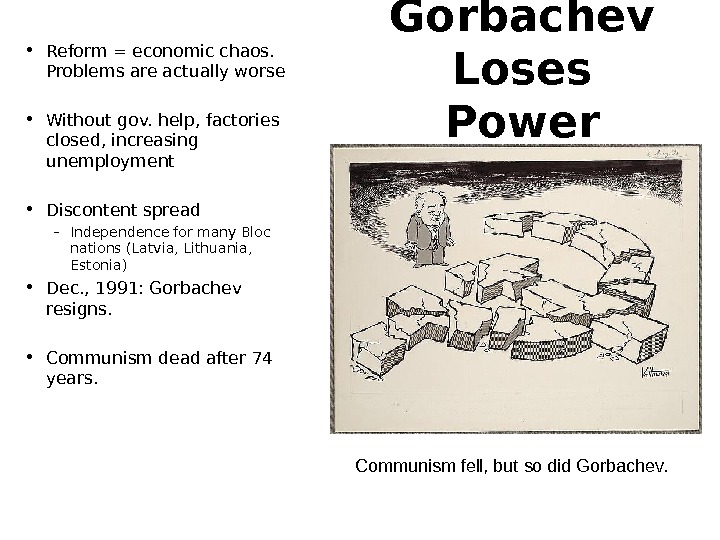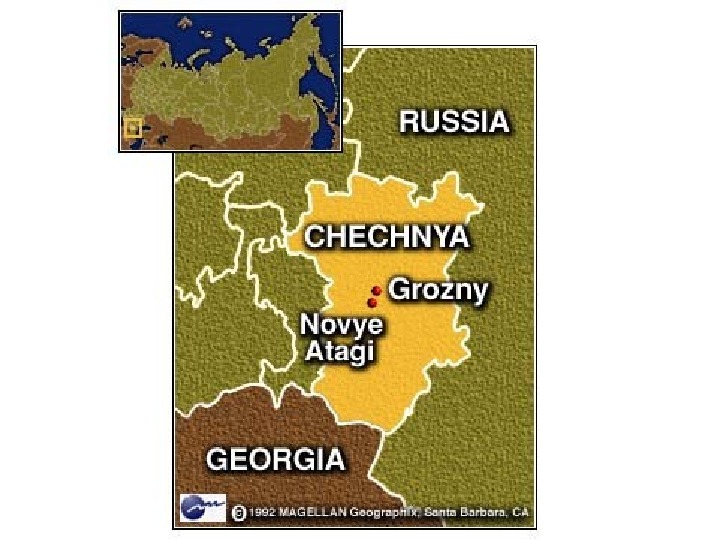Презентация fall of communism yugoslavia























- Размер: 1.6 Mегабайта
- Количество слайдов: 22
Описание презентации Презентация fall of communism yugoslavia по слайдам
 Fall of Communism
Fall of Communism
 Soviet “Bloc” or “satellite” nations
Soviet “Bloc” or “satellite” nations
 Breshnev Doctrine — The USSR would intervene in any satellite nation that seemed to be moving away from communism. -Invasion of Czeckoslovakia in 1968.
Breshnev Doctrine — The USSR would intervene in any satellite nation that seemed to be moving away from communism. -Invasion of Czeckoslovakia in 1968.
 Detente • Definition: Easing of tension between the USSR and US in the 1970 s • Ended in 1979 – Soviet support of anti-western movements – Neither nation willing to give up nuclear weapons. – Soviet invasion of Afghanistan.
Detente • Definition: Easing of tension between the USSR and US in the 1970 s • Ended in 1979 – Soviet support of anti-western movements – Neither nation willing to give up nuclear weapons. – Soviet invasion of Afghanistan.
 SOVIET ECONOMY UNDER BRESHNEV-Inefficient and troubled -Decline in standard of living -Agricultural failures -Inadequate transportation -Outdated factories -Heavy military spending -1982: Breshnev dies (need for economic reform was clear)
SOVIET ECONOMY UNDER BRESHNEV-Inefficient and troubled -Decline in standard of living -Agricultural failures -Inadequate transportation -Outdated factories -Heavy military spending -1982: Breshnev dies (need for economic reform was clear)
 The Gorbachev Revolution • 1985: Mikhail Gorbachev becomes new leader • Renounced Brezhnev Doctrine – Improve economy by reducing military spending – Pulled troops out of Afghanistan • Must make an agreement with the United States about nuclear weapons
The Gorbachev Revolution • 1985: Mikhail Gorbachev becomes new leader • Renounced Brezhnev Doctrine – Improve economy by reducing military spending – Pulled troops out of Afghanistan • Must make an agreement with the United States about nuclear weapons
 Gorbachev Reform • Glasnost: “openness” – Ended censorship, encouraged discussion of problems – People could speak freely and read whatever they wanted. • Perestroika – Restructuring of the government and economy – Reduced size of bureaucracy – “ essence of communism” • State still owns factories, but managers make decisions • Land is still owned by state, but farmers can have more for personal profit
Gorbachev Reform • Glasnost: “openness” – Ended censorship, encouraged discussion of problems – People could speak freely and read whatever they wanted. • Perestroika – Restructuring of the government and economy – Reduced size of bureaucracy – “ essence of communism” • State still owns factories, but managers make decisions • Land is still owned by state, but farmers can have more for personal profit
 Relations with U. S. improved Gorbachev and Ronald Reagan met several times to sign several arms-reduction agreements Perestroika mad more consumer goods available, but there were still shortages of basic necessities Freedom of speech provided by glassnost increased tensions between various Soviet ethnic groups and nationalities. Rival groups could now express opinions. Ethnic fighting broke out between the Muslim Soviet republic of Azerbaijan and the Christian Soviet republic of Armenia.
Relations with U. S. improved Gorbachev and Ronald Reagan met several times to sign several arms-reduction agreements Perestroika mad more consumer goods available, but there were still shortages of basic necessities Freedom of speech provided by glassnost increased tensions between various Soviet ethnic groups and nationalities. Rival groups could now express opinions. Ethnic fighting broke out between the Muslim Soviet republic of Azerbaijan and the Christian Soviet republic of Armenia.
 Gorbachev Loses Power • Reform = economic chaos. Problems are actually worse • Without gov. help, factories closed, increasing unemployment • Discontent spread – Independence for many Bloc nations (Latvia, Lithuania, Estonia) • Dec. , 1991: Gorbachev resigns. • Communism dead after 74 years. Communism fell, but so did Gorbachev.
Gorbachev Loses Power • Reform = economic chaos. Problems are actually worse • Without gov. help, factories closed, increasing unemployment • Discontent spread – Independence for many Bloc nations (Latvia, Lithuania, Estonia) • Dec. , 1991: Gorbachev resigns. • Communism dead after 74 years. Communism fell, but so did Gorbachev.

 Communist Party Voted Out
Communist Party Voted Out
 1991: Russia Under Yeltsin • 1991: Boris Yeltsin president of Federation of Russia (largest and most powerful of the newly independent states) – 1993: Dissolves legislature • Privatization of state-run industries and farms • Orthodox church regained strength • High unemployment and prices – Led to organized crime, prostitution, and corruption
1991: Russia Under Yeltsin • 1991: Boris Yeltsin president of Federation of Russia (largest and most powerful of the newly independent states) – 1993: Dissolves legislature • Privatization of state-run industries and farms • Orthodox church regained strength • High unemployment and prices – Led to organized crime, prostitution, and corruption
 Problems in Russia • 1994: Revolt in Chechnya. Want to secede (rich in oil) – Many ethnic groups, but mostly Muslim • 1996: Peace treaty (International criticism and heavy casualties) • 1999: Terrorist activity in Moscow by Chechen rebels • 1999: Russian troops invade again=Stalemate • 2000 and on: Vladimir Putin hard line against Chechnya. • http: //www. youtube. com/watch? v=07 zq 8 fi. G 1 J 0&feature=fvsr
Problems in Russia • 1994: Revolt in Chechnya. Want to secede (rich in oil) – Many ethnic groups, but mostly Muslim • 1996: Peace treaty (International criticism and heavy casualties) • 1999: Terrorist activity in Moscow by Chechen rebels • 1999: Russian troops invade again=Stalemate • 2000 and on: Vladimir Putin hard line against Chechnya. • http: //www. youtube. com/watch? v=07 zq 8 fi. G 1 J 0&feature=fvsr

 Vladimir Putin • Member of Soviet secret police, reputation for ruthlessness. Not a strong supporter of Democracy. • Acting president in 1999 when Yeltsin resigned, elected in 2000 • Unable to stop terrorist activity by Chechen rebels • Corruption is still a problem
Vladimir Putin • Member of Soviet secret police, reputation for ruthlessness. Not a strong supporter of Democracy. • Acting president in 1999 when Yeltsin resigned, elected in 2000 • Unable to stop terrorist activity by Chechen rebels • Corruption is still a problem
 15 Republics = The Commonwealth Established
15 Republics = The Commonwealth Established
 Yugoslavia • Made up of 6 republics and many different ethnic groups (Serbs, Croats, Slovenians, Macedonians, Albanians) • Different religions: – Serbs: Eastern Orthodox – Croats and Slovenians: Roman Catholic – Bosnia and Herzogovina: Muslim When Communism fell: Serbia under President Slobodan Milosevic tried to dominate all of Yugoslavia. – 1991: Slovenia and Croatia declared independence – Serbia and Croatia went to war ending in a truce mediated by the UN.
Yugoslavia • Made up of 6 republics and many different ethnic groups (Serbs, Croats, Slovenians, Macedonians, Albanians) • Different religions: – Serbs: Eastern Orthodox – Croats and Slovenians: Roman Catholic – Bosnia and Herzogovina: Muslim When Communism fell: Serbia under President Slobodan Milosevic tried to dominate all of Yugoslavia. – 1991: Slovenia and Croatia declared independence – Serbia and Croatia went to war ending in a truce mediated by the UN.
 Former Yugoslavia
Former Yugoslavia
 1992: Bosnia declares independence BOSNIA -Greatest challenge: diverse population -Muslims formed the largest single religious group. (did not form a majority) -1/3 rd of population identified themselves as Serbian -1/5 claim to be Croatian. -Many Bosnian Serbs wanted to remain part of Serbian-dominated Yugoslavia. -Receiving aid from the Yugoslavian government in Belgrade, Bosnian Serbs began a program of ethnic cleansing : a campaign of terror and murder intended to drive the Muslims out of areas Bosnian Serbs claimed.
1992: Bosnia declares independence BOSNIA -Greatest challenge: diverse population -Muslims formed the largest single religious group. (did not form a majority) -1/3 rd of population identified themselves as Serbian -1/5 claim to be Croatian. -Many Bosnian Serbs wanted to remain part of Serbian-dominated Yugoslavia. -Receiving aid from the Yugoslavian government in Belgrade, Bosnian Serbs began a program of ethnic cleansing : a campaign of terror and murder intended to drive the Muslims out of areas Bosnian Serbs claimed.
 Ethnic Cleansing • Bosnia – U. N. stops the flow of weapons into the region. (Actually made it harder for Muslim-controlled Bosnian gov. to fight off better armed Serbs. ) – UN set up protected safe havens (did not stop Serbs who continued to bomb the capital of Sarajevo as well as safe havens) – At least 30, 000 Bosnian Muslims were executed, tortured, or made into refugees – 1995: NATO airstrikes against the Bosnian Serb military • Dayton Accord – Gave Bosnian Serbs control over certain areas while still recognizing the overall sovereignty of Bosnia’s Muslim led government.
Ethnic Cleansing • Bosnia – U. N. stops the flow of weapons into the region. (Actually made it harder for Muslim-controlled Bosnian gov. to fight off better armed Serbs. ) – UN set up protected safe havens (did not stop Serbs who continued to bomb the capital of Sarajevo as well as safe havens) – At least 30, 000 Bosnian Muslims were executed, tortured, or made into refugees – 1995: NATO airstrikes against the Bosnian Serb military • Dayton Accord – Gave Bosnian Serbs control over certain areas while still recognizing the overall sovereignty of Bosnia’s Muslim led government.
 1998: Kosovo Ethnic Albanians demanded independence for Kosovo The Serbian government cracked down and sent troops in. (Ethnic cleansing part 2) 1999: NATO bombed for 11 weeks: Serbian forces withdrew. Kosovo placed under UN control — Feb, 2008: Kosovo declared itself indepenent (Security council members: USA, France, and UK recognize them. Russia and China do not. )
1998: Kosovo Ethnic Albanians demanded independence for Kosovo The Serbian government cracked down and sent troops in. (Ethnic cleansing part 2) 1999: NATO bombed for 11 weeks: Serbian forces withdrew. Kosovo placed under UN control — Feb, 2008: Kosovo declared itself indepenent (Security council members: USA, France, and UK recognize them. Russia and China do not. )
 The End for Milosevic • Overthrown in 2003 • Yugoslavia becomes Serbia and Montenegro – Montenegro seceded • Milosevic accused and set to be tried for war crimes. Died before sentencing.
The End for Milosevic • Overthrown in 2003 • Yugoslavia becomes Serbia and Montenegro – Montenegro seceded • Milosevic accused and set to be tried for war crimes. Died before sentencing.

